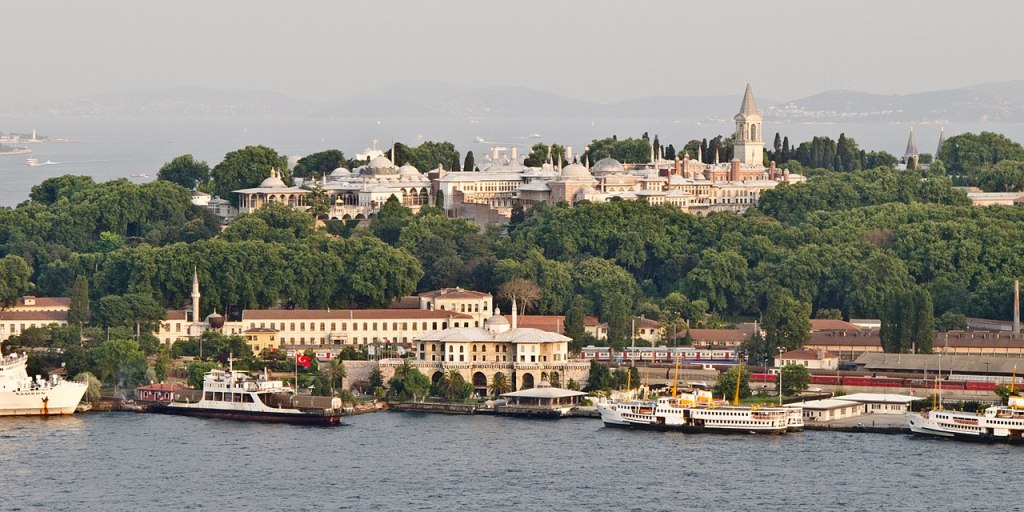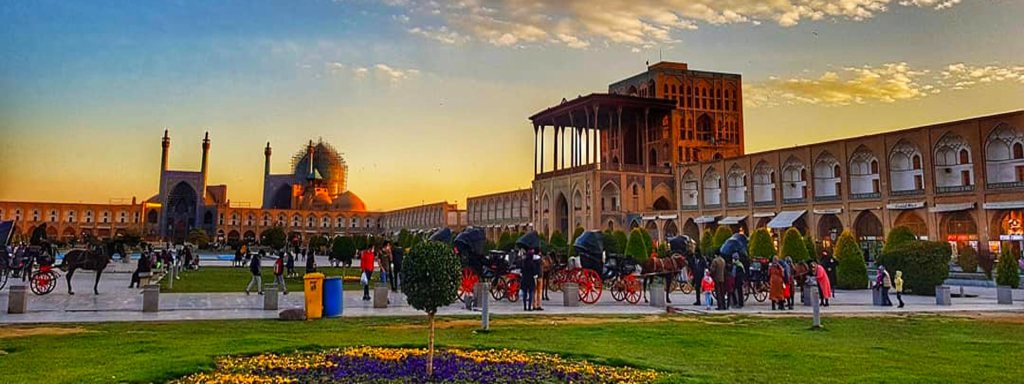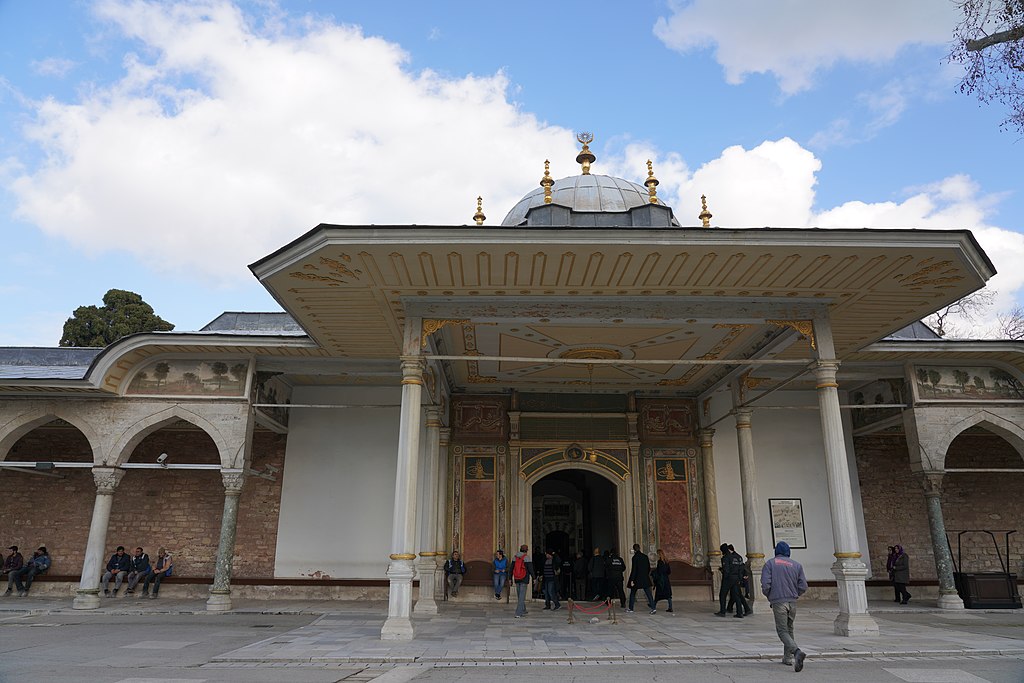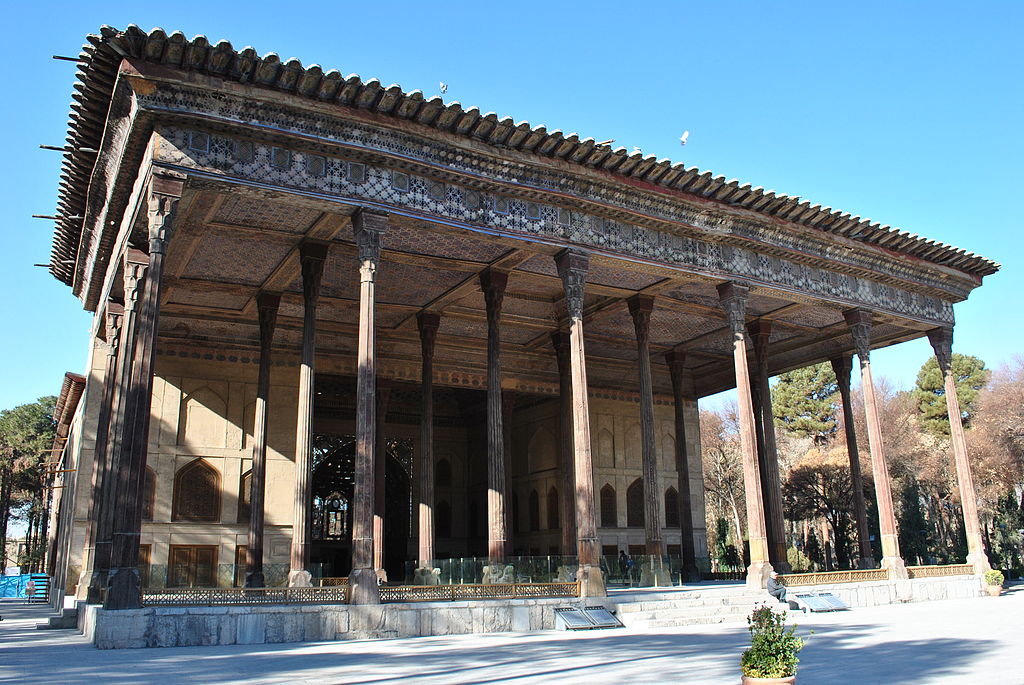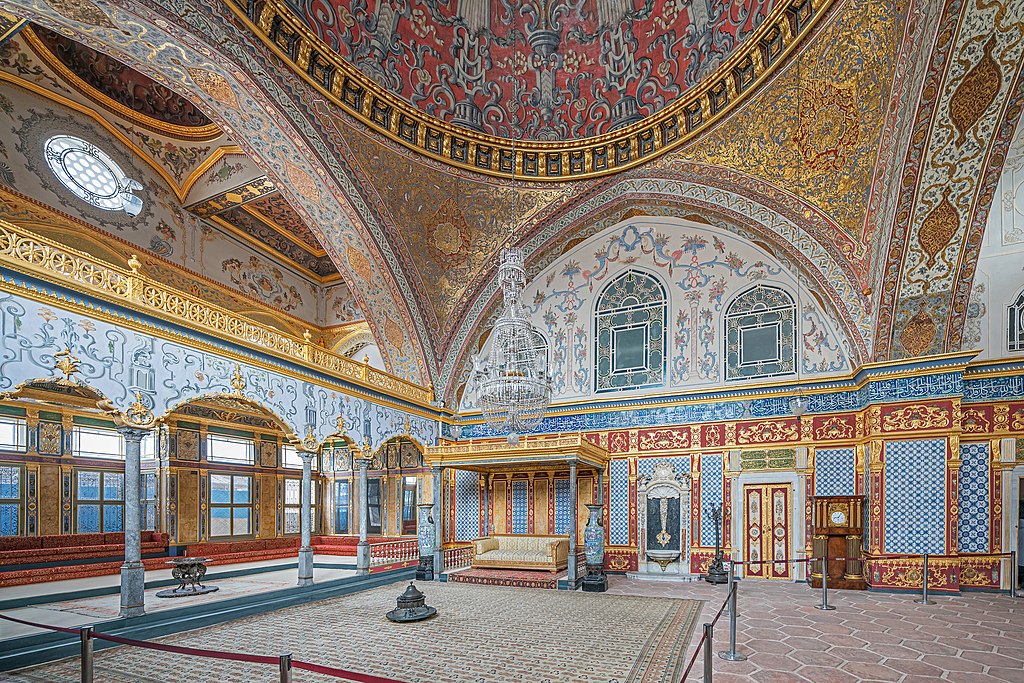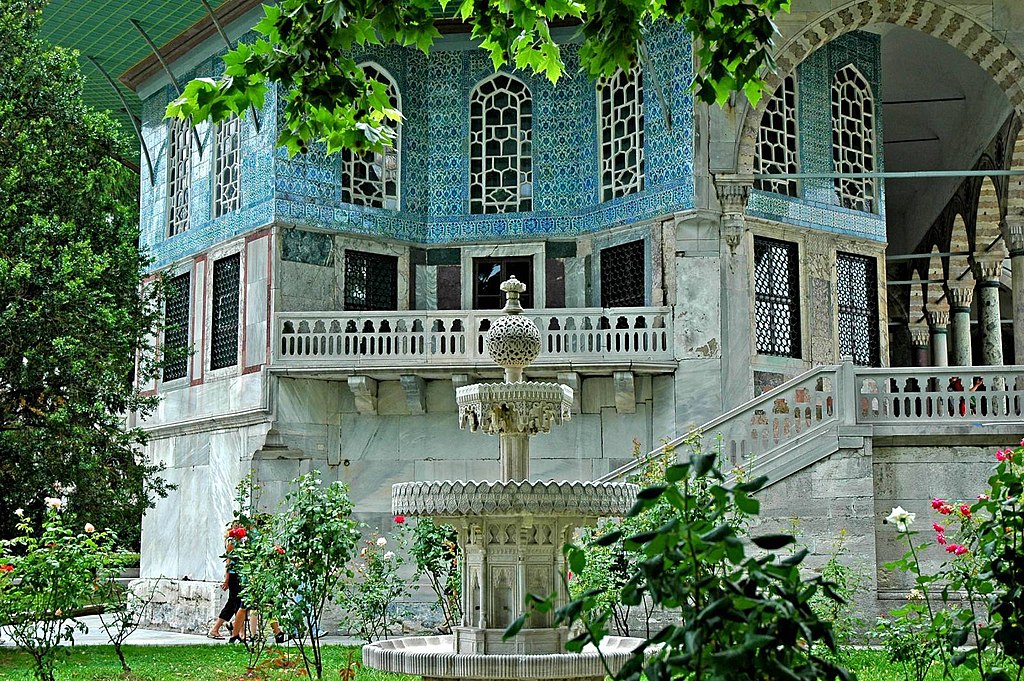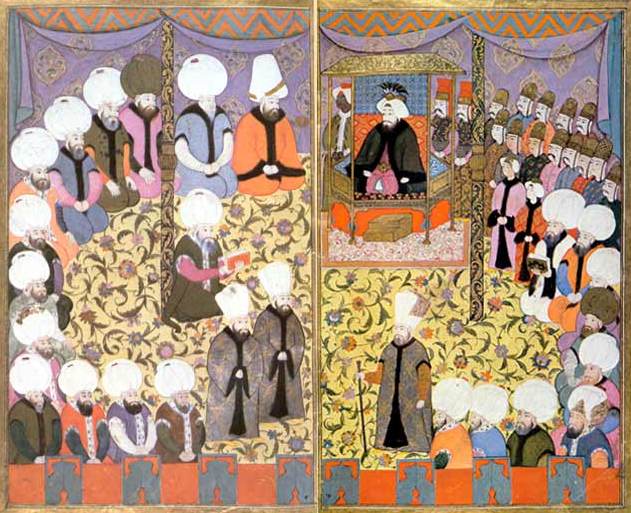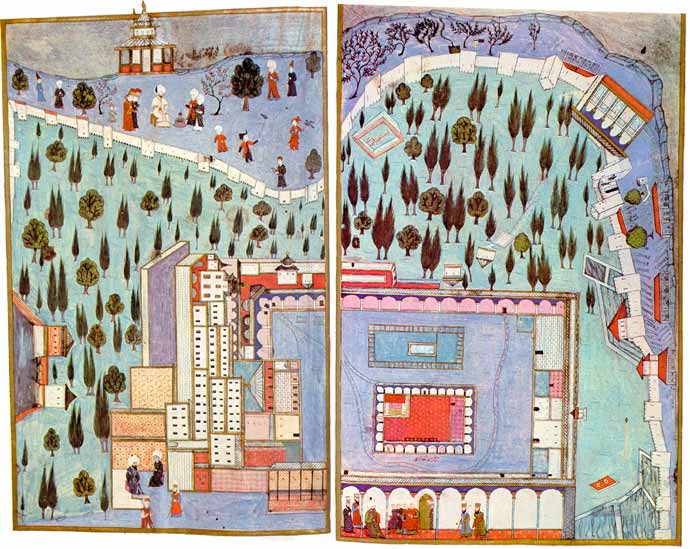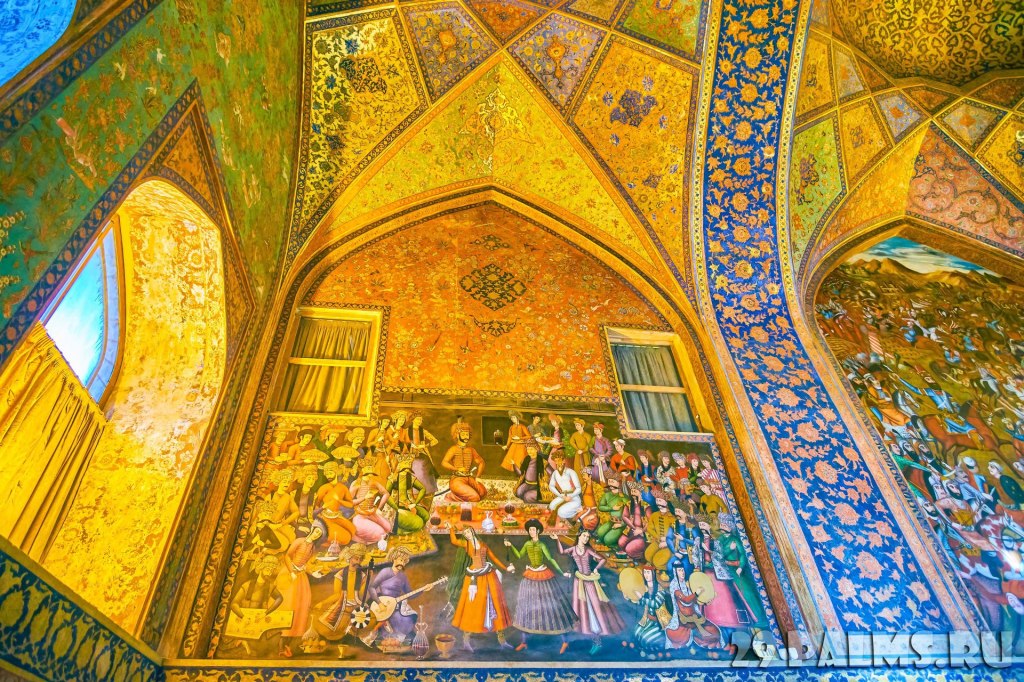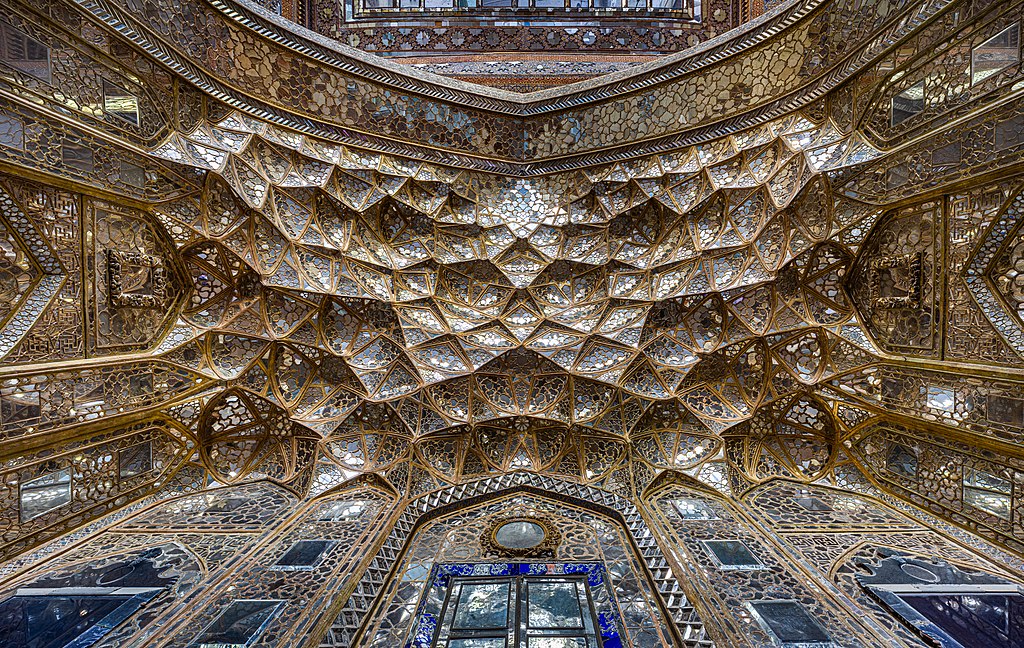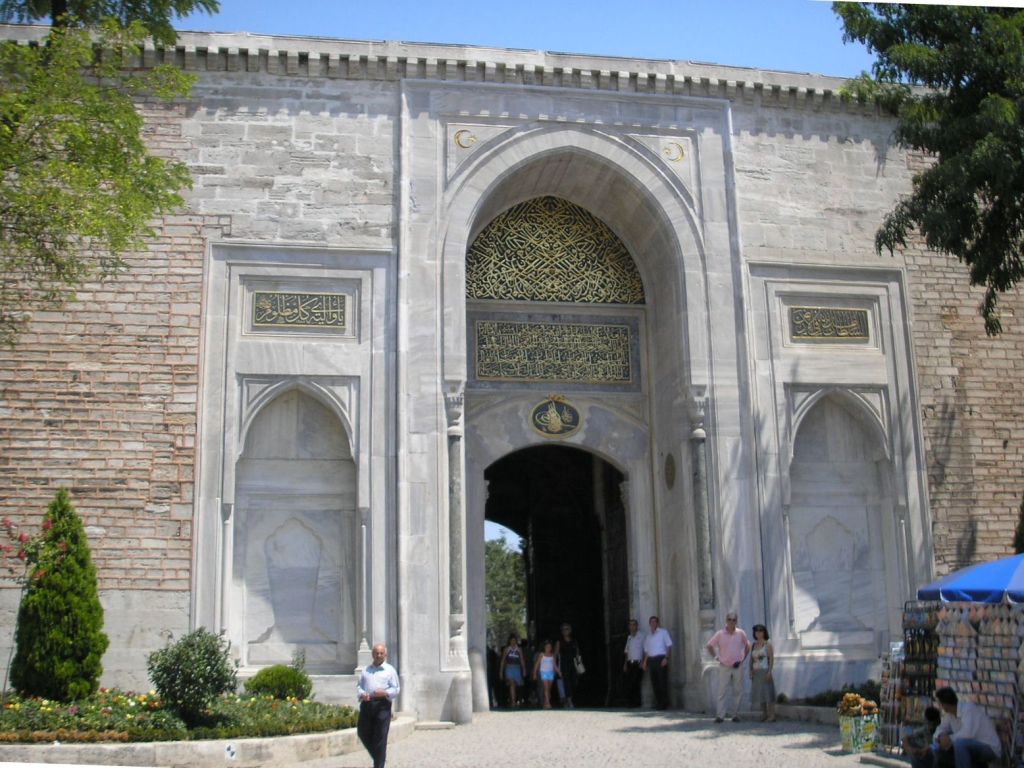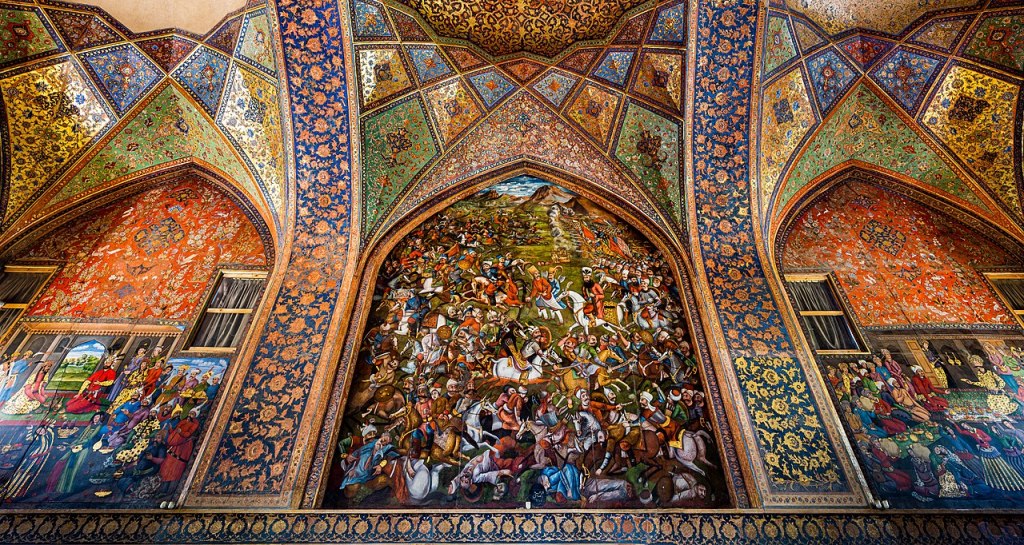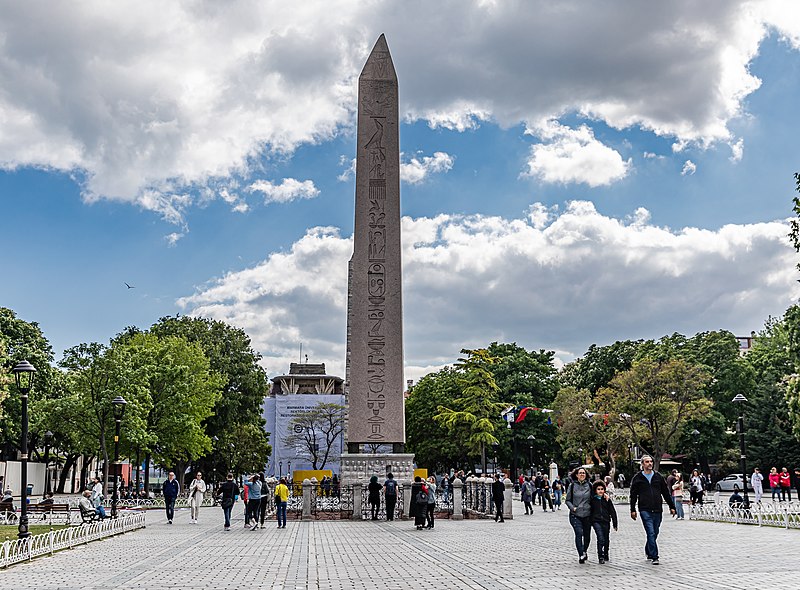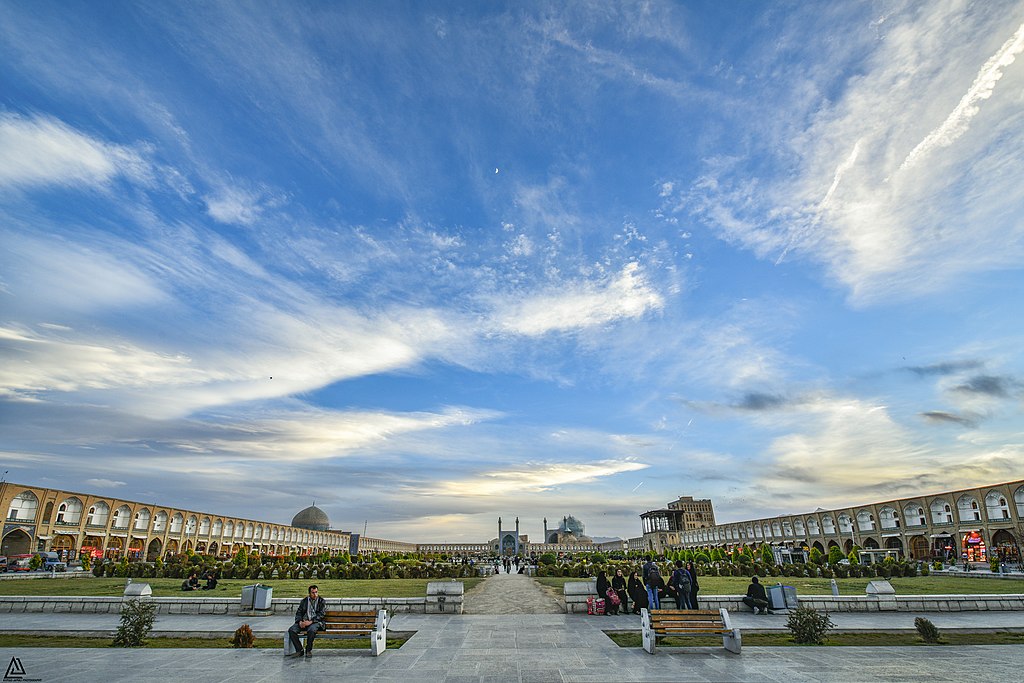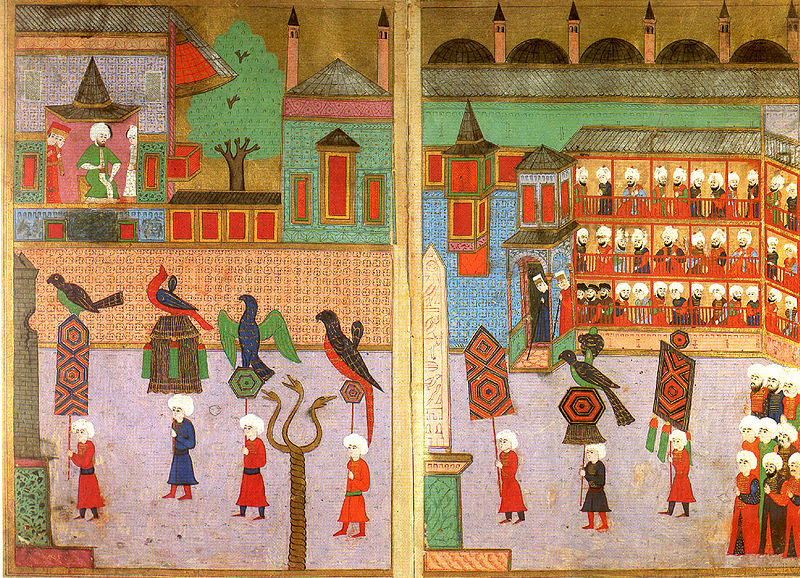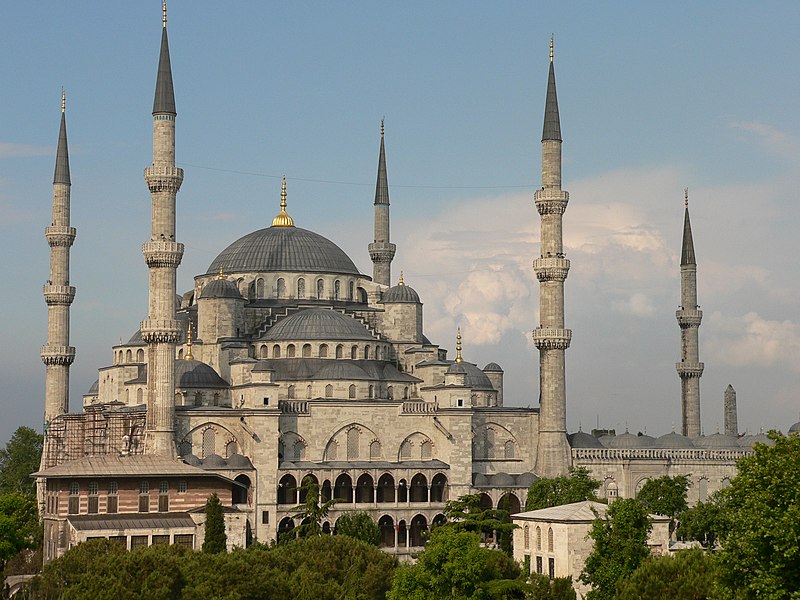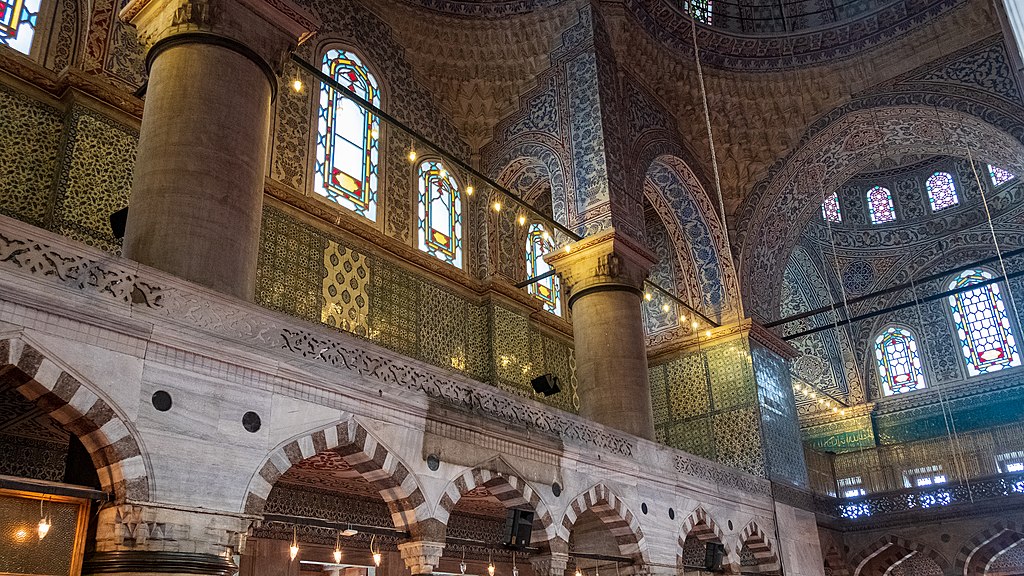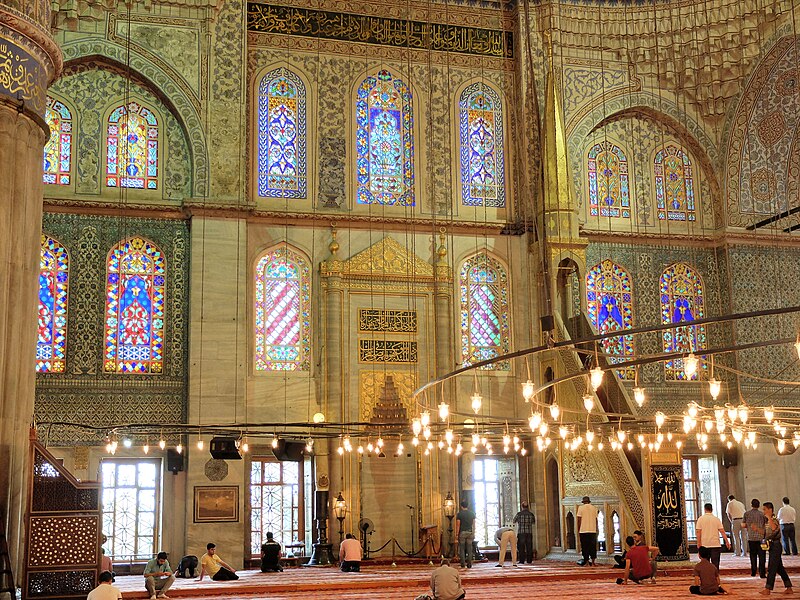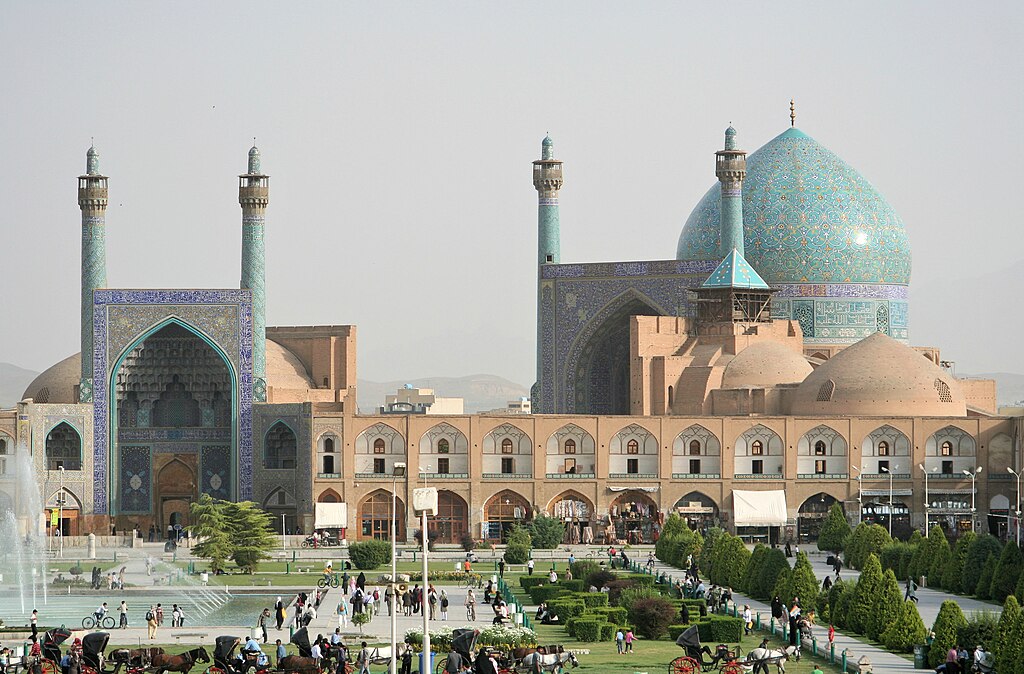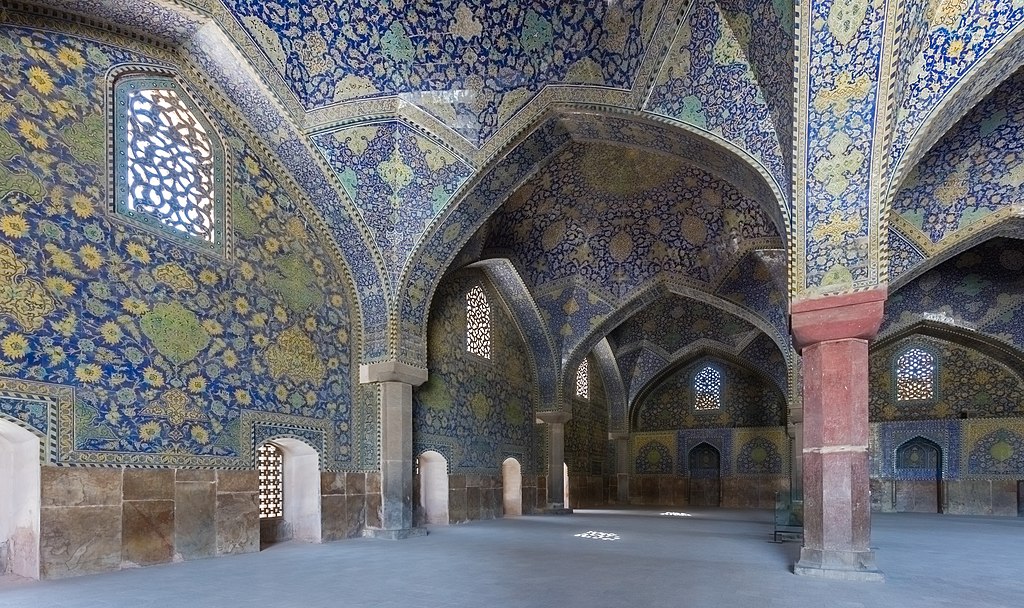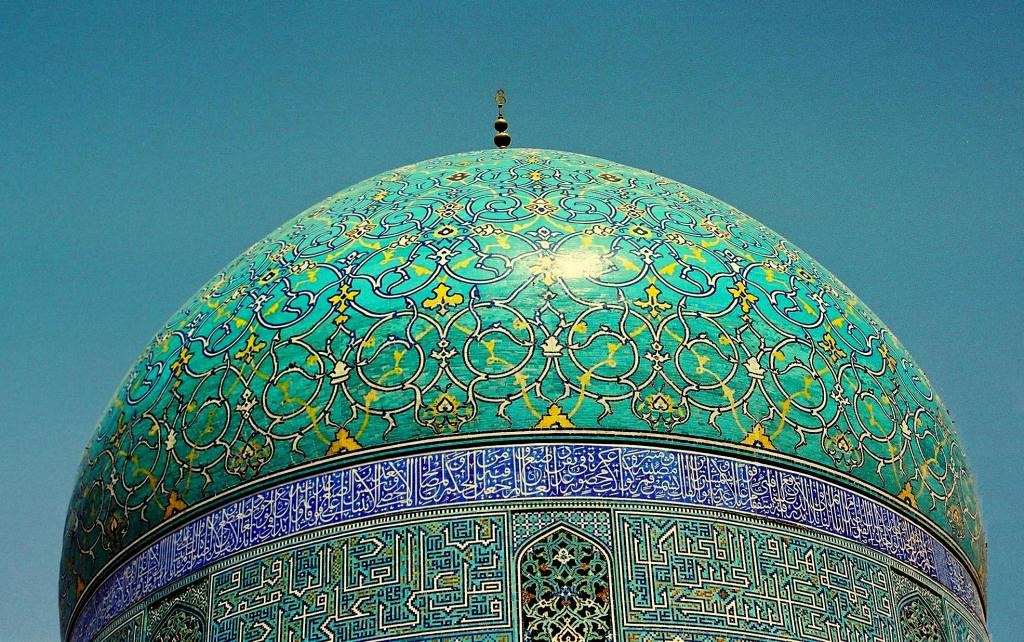Pre-publication of chapter XXVIII of my forthcoming book “Turkey is Iran and Iran is Turkey – 2500 Years of indivisible Turanian – Iranian Civilization distorted and estranged by Anglo-French Orientalists”; chapters XXVII to XXXII form Part Eleven (How and why the Ottomans, the Safavids and the Mughals failed) of the book, which is made of 12 parts and 33 chapters. Chapter XXVII has already been pre-published.
Until now, 17 chapters have been uploaded as partly pre-publication of the present book; this chapter is therefore the 18th (out of 33) to be uploaded. At the end of the text, the entire Table of Contents is made available. Pre-published chapters are marked in blue color, and the present chapter is highlighted in green color.
In addition, a list of all the already pre-published chapters (with the related links) is made available at the very end, after the Table of Contents.
The book is written for the general readership with the intention to briefly highlight numerous distortions made by the racist, colonial academics of Western Europe and North America only with the help of absurd conceptualization and preposterous contextualization.
———————–
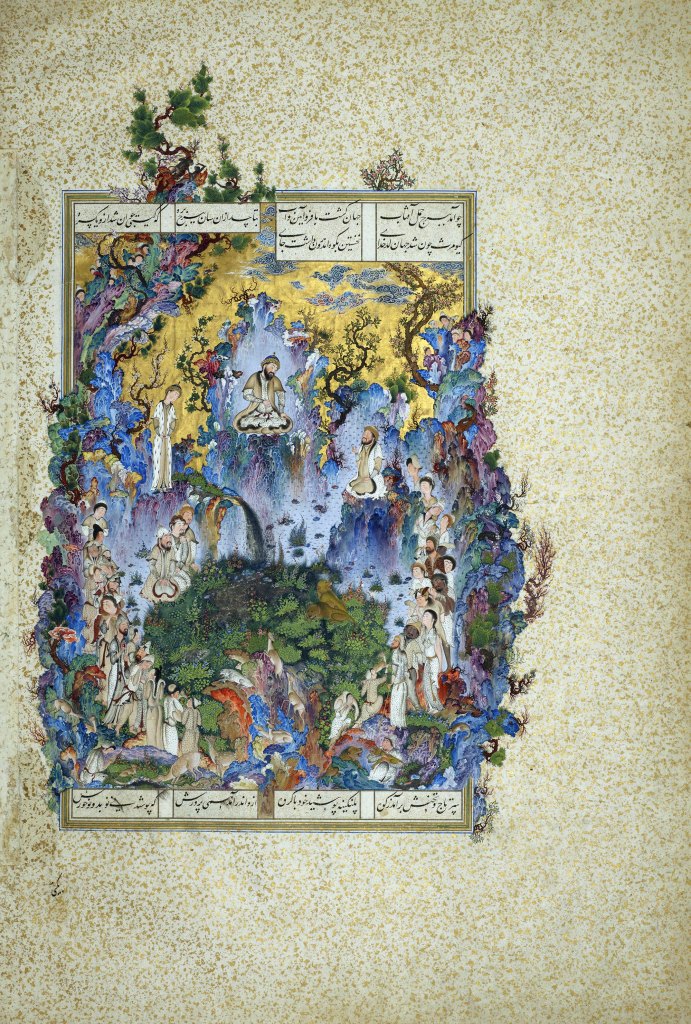
Keyumars: the central figure of Islamic mysticism, as he encompasses the souls of all prophets and kings. The miniature presents a vision of the “The Court of Keyumars” and it was painted by the illustrious Safavid court artist Sultan Muhammad around 1522. Who is Keyumars? Mentioned as Gayo Maretan in the Avesta and as Gayomard in Parsi (: late Zoroastrian) texts of Islamic times, he was superbly mythologized by Ferdowsi in his Shahnameh as the First Man, the First King, and the Founder of the Pishdadian dynasty of Righteous Rulers. Keyumars epitomizes life within a mortal world, thus setting in motion the concept of eternal presence and heralding the ultimate victory of the Messiah as the New (or Last) Keyumars.
Currently, the most common encyclopedic definitions of the two terms present these two distinct activities as overlapping or describe spirituality as a part of religion; this is however wrong, if it is considered as valid for all the religions of the world. Many historical religions started as a form of systematization of spirituality and of spiritual rules and they ended up as totally materialistic, rationalistic, and juristic systems of theology. The representatives of these systems have nothing to do with spirituality; they hate the spiritual universe about which they talk too much but only to confuse and besot the rest, and in the Name of God, they commit the world’s cruelest crimes in order to defend their otherwise nonexistent right to survive.
Irrespective of posterior alterations, deteriorations and degenerations, the original fact has always been spirituality; contrarily to religion, spirituality does not need a society to be activated, performed, and experienced. Spirituality is the cornerstone and the epitome of humanity. The human being was created as a unity of soul and body, and if one of the parts of the human identity is disconnected from the other, the being is not human anymore. In the human being, the soul represents the being’s connection to the spiritual world and the body consists in the being’s bond with the material world. What material vivacity is for the body is spiritual life for the soul.
Separation of the soul from the body is called death; disconnection of the soul from the body is also a form of death, and this was hinted at by numerous leading spiritual masters, like for instance Jesus (e.g. “let the dead bury their own dead”; Matthew 8:22). Since God is the Supreme Spiritual Being and the Creator of the spiritual and the material universes, the soul of the man connects, or does not connect, to God. And this is exactly what spirituality is about: spiritual life.
In other words, whereas human society is useless, worthless and unnecessary for the human being to exist and to live, spirituality encompasses all actions, practices, exercises, efforts and techniques pertaining to the interaction between a human being’s soul and body (: heart and mind) and to the activation of a human being’s connection with the spiritual universe – and with the countless spiritual beings and hierarchies that are set in motion and operate therein. Because spirituality, namely spiritual life, is of the foremost importance in the human being’s passage from the material world, many spiritual masters, mystics and spiritually active men departed from their society or lived a secluded life; this was due to the fact that human society can be either unnecessary or even harmful to a person’s spirituality. This common phenomenon is attested in numerous civilizations, and in some of them, it takes the form of asceticism or monasticism.
The early religions in Mesopotamia (Sumer, Elam, Akkad, Assyria, and Babylon), Anatolia (Hatti, Hurrians, Hittites, and Luwians), Egypt, Cush (Sudan), Canaan, and Iran were systems that offered their apprentice priests the possibility to
a) learn and practice all levels of soul-body (spiritual/material) interaction in a human being,
b) comprehend the nature, the norms, and the dimensions of the spiritual and material universes, the stages of their creation, and the phases of their final dissolution (every Cosmogony involves a Cosmology, a Soteriology, and an Eschatology), and
c) learn and perform all types of synergy with spiritual beings and hierarchies as per the needs and the targets set.
To be properly understood, the aforementioned has to be taken into consideration in the light of the following four critical points:
i. the ‘language’ used for the spiritual initiation, formation, education and activation of the apprentice priests by the hierophants and the high priests was the archetypal Oriental Myth, i.e. the inherently created and permanently manifested, within the human being, system of spiritual perception and comprehension, communication and interaction with all other intelligences, spiritual beings, humans, animals, plants and other beings of the material universe. In and by itself, the original Oriental Myth is the complete field of symbolic semiotics that encompasses all forms of Being and Becoming, their opposites, and the correlation between Being and Non-being. In other words, it is part of the Creation, and not a human invention or perception.
ii. the spiritual exercises, practices, advance and completion of the apprentice priests took place irrespective of the spiritual/material duality of Moral Order, i.e. the Good and Evil; this does not mean that this duality is irrelevant. On the contrary, the spiritual duality was reflected on the material universe, and there were entire priesthoods that preached and practiced a counterfeit, evil spirituality at the very antipodes of the moral priesthoods, which followed the Moral Order, i.e. the Law of God.
iii. the aforementioned duality of Moral Order has a lot to do with the Fall of Man or rather the successive stages of the Fall, which are known as the Flood, the Tower of Babel, etc. within the Ancient Hebrew (Biblical) religious context, and accordingly in other, earlier or later, civilizations. These stages of gradual moral degradation caused a) the progressive disconnection of the soul from the body in most of the humans,
b) the subsequent dissociation of the human being from the spiritual universe,
c) the subordination of the immoral, counterfeit priesthoods to the fallen spiritual beings,
d) the deterioration of the conditions of material life on Earth,
e) the preservation of the spiritual potency among several sacerdotal circles during the 3rd and the 2nd millennium BCE, and
f) the abysmal confrontation between the moral and the immoral priesthoods as part of the clash between Good and Evil in both, the spiritual and the material, universes.
One of the repercussions of this confrontation was the compilation of counterfeit religions geared to engulf humans not only to spiritual disconnection, but also to spiritual impotence and black magic; the very concept of an ‘intermediate’ (being, priest, idol, thought or anything) between the human being and God is the epitome of black magic, as it helps transfer spiritual and material (intellectual) power from an impotent, unconscious and spiritually disconnected human being to another person that gets criminally powered at both, the spiritual and the material, levels, therefore resulting in impermissible and lawless exploitation.
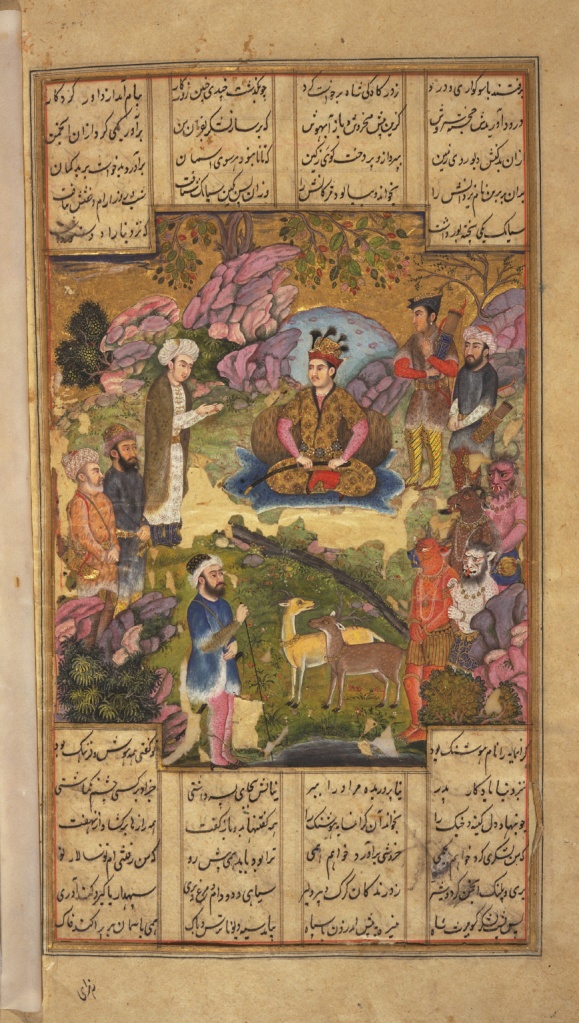
Keyumars instructs his officers to combat Ahriman: this is how the preaching of all the prophets in encapsulated in one symbolic representation. Spirituality does not need volumes of otherwise useless treatises to set the norms and convey the truth about Life.
iv. at the very early days of the History of Mankind, spirituality constituted the epicenter of religion, and so it was in every teaching and practice of a great spiritual master. All true founders of religions were basically leading spiritual masters, who did not launch ‘religions’ properly speaking, but taught their disciples and preached at large the authentic spirituality (the interaction between the human being’s soul and body, and the human being’s connection with the spiritual universe) and the inherent (since the Creation) Moral Order that all humans must follow.
In fact, religion came later either in the simple form of systematization of spirituality and of spiritual rules within the context of human society where the Moral Order should prevail or in the perplex form of counterfeit religions with black magic rituals of many types, i.e. ‘cult’.
Now, if one wants to understand what spiritual potency means, one can find plenty of examples in every literature, tradition, culture and civilization. Within the context of Christianity, one can refer to the well–known excerpt from the Gospel of Matthew (17:20) in which Jesus says to his disciples the following:
“Because you have such little faith”, he told them. “I tell you, if you have faith even as small as a mustard seed, you could say to this mountain, ‘Go from here to over there’, and it would do it, and nothing would be impossible for you”.
Among numerous other deeds, which are nowadays erroneously (and due to the aforementioned, successive falls of Mankind) considered as ‘miraculous’, spiritual potency of a human involves the following: levitation, walking on water, telekinesis, teleportation across distances, healing, total control of electromagnetic fields, bodily luminescence, control over all natural forces, movement across various points in time, transfiguration, power over fallen (or evil, demonic) spirits and hierarchies, resurrection of the dead, and heavenly travels, like those of
a) the Biblical Enoch (Islamic Idris),
b) the Biblical Elijah (Islamic Ilyas),
c) Jesus (Islamic Isa),
d) Mani, the prophet and founder of Manichaeism,
e) Kartir, the leading theologian and high priest of the Mazdaean religion during the early Sassanid times,
f) the legendary Arda Viraf of the Parsis (as described in the Arda Wiraz namag), and
g) Prophet Muhammad, i.e. the well-known Isra’ and Mi’raj (الإسراء والمعراج) nocturnal travel; about:
https://en.wikipedia.org/wiki/Elijah#Ascension_into_the_heavens
https://en.wikipedia.org/wiki/Ascension_of_Jesus
https://iranicaonline.org/articles/kartir (iii. Kartīr’s Inscriptions, Kartīr’s career and promotions; THE JOURNEY)
https://iranicaonline.org/articles/arda-wiraz-wiraz
https://en.wikipedia.org/wiki/Isra_and_Mi%27raj
As the fall of human societies and the decline of the human condition intensified, spirituality was reduced tremendously and the spiritual potency of most of the priesthoods became nil, with the exception of those whose spiritual power was not theirs anymore, but that of the demons inhabiting the souls of the priests who were acting as mere servants of negative hierarchies.
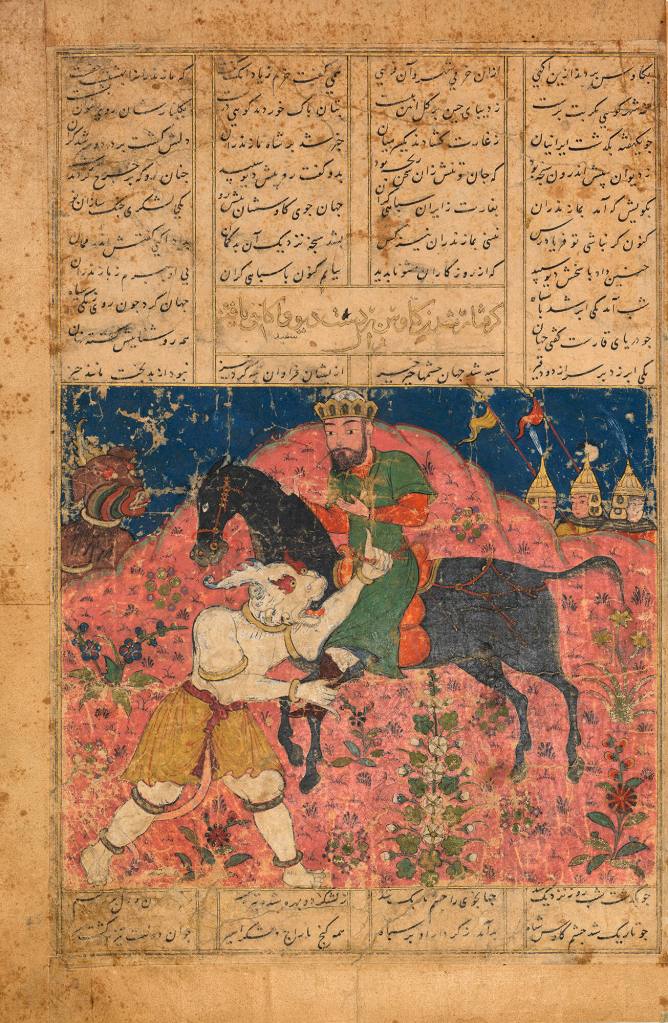
The fall of Mankind is symbolized within the context of Islamic mysticism by Kay Kavus, the second king of the Kayanian dynasty; in this miniature, Kay Kavus (son of the sublime Kay Kawad (or Kay Qubad), father of the misfortunate Siyavash (or Siyavush), and grandfather of Kay Khusraw, the resolute, selfless soldier and end times’ vanquisher) is being captured by the divs, i.e. the evil spirits that work for Ahriman.
As spiritual power among humans decreased considerably and was limited among few circles of priests and mystics or in isolated cases of ascetics, the condition of human life was restricted to the material level, and then an enormous materialistic, rationalistic, and juristic literature surfaced only to verbally and nominally guide the believers to the ‘correct path’, which was of course not correct and not a path, but a catastrophic swamp and a wrong impasse. Then, the ‘faithful’ were truly left without ‘faith’, because this term originally denoted only the spiritual potency acquired by an individual (as it is clearly shown in the aforementioned example).
In fact, the spiritual connotation of the word ‘faith’ means performance of acts, which in today’s fallen world are considered ‘miraculous’, but in reality they are not. ‘Faith’ does not mean mere acceptance of a narrative; this is a devious, degenerated and corrupt meaning of this word. This materialistic, rationalistic, and juristic literature, which appeared in later periods, among decadent nations, reduced the original Oriental Myth to a meaningless narrative about past times; this contributed to the alteration of the earlier form of religion, rendering some narratives ‘incredible’ or ‘inexplicable’, due to the proliferation of the idiotic rationalism of the fallen humans. Then, the worthless believers accepted the ‘unbelievable’ stories blindly, further worsening their condition of grave faithlessness (without of course realizing the calamitous situation in which they found themselves).
This worthless verbosity of materialistic, rationalistic, and juristic character is called nowadays “theology”. This means simply that what the average Assyrian, Egyptian, Babylonian, Phoenician and Hebrew of the 10th c. BCE knew as ‘Flood’ had nothing in common with the de-mythicized and therefore meaningless idea that the average Babylonian, Egyptian, Aramaean, Jew, Greek and Roman of the 1st c. BCE believed about that critical event. The same concerns the followers of later religions today, but not the disciples and the believers of later mystics and spiritual masters who had managed to attain the lost spirituality.
The term “theology” does not therefore apply properly to the earlier sacred texts of the 3rd and the 2nd millennium BCE; whatever their contents may have been (mythical, apocalyptic, moral, literary, etc.), the earlier sacred texts of all religions were in fact ‘texts of spiritual awakeness’ – except for sacerdotal texts compiled by immoral, counterfeit and polytheistic priesthoods.
The preservation of socioeconomic power by the theological gangs and all those, who distorted the early systems of spirituality and defiled the spiritual teachings of later mystics and spiritual masters, was their main concern. For these preposterous theologians, morality among believers did not constitute the true promise of an individual’s spiritual rehabilitation and ultimate salvation, but a means to implement their own anti-spiritual, anti-godly, material(istic) takeover of the society.
Theology therefore signifies the death of spirituality, the falsification of religion, and the degeneration of the sacred texts in the minds of the believers; for this purpose, the average believer’s mindset is aptly distorted, the earlier faith is disoriented, and the people are made unable to ever perceive and understand correctly all things spiritual. Consequently, theologically hijacked religions are tantamount to systems of mental, intellectual, educational, academic, cultural, artistic and socio-economic prison and tyranny. They apparently ended up in the putrefaction of the human being.
There is an exception to the aforementioned; it occurs when there is no established religion but conflicting theological systems, and then the various theologians act like profane philosophers trying to pull their followers to this or that theme and belief that they want to highlight and propagate. This confusing situation may trigger eventually fanaticism, but at times, the worst has been averted due to a shrewd theologian, who prevented others from presenting even worse concepts.
This is the situation that Jesus faced opposite the Pharisees and Muhammad encountered, when confronting either the Jews and the idolatrous Arabs of Hejaz or the Constantinopolitan Christian clergymen, who forced Emperor Heraclius not to accept the invitation to Islam that the prophet extended to him. In reality, spirituality was defamed as black magic within Christianity by those who turned Jesus’ teaching into a black magic shamelessly performed in his name.
All spiritual mystics had to either permanently hide themselves or to develop and diffuse various forms of lesser theological distortion, which were then labeled as ‘heresies’ by the theological gangsters. The situation turned worse when mystics and theologians developed and launched systems of Christian spirituality limited only to the initiated members of secret religious orders (which was another form of hiding). For the average people, this meant that only as a monk or the member of a secret religious order, they could perhaps reconstitute the bond between their soul and their body in themselves.
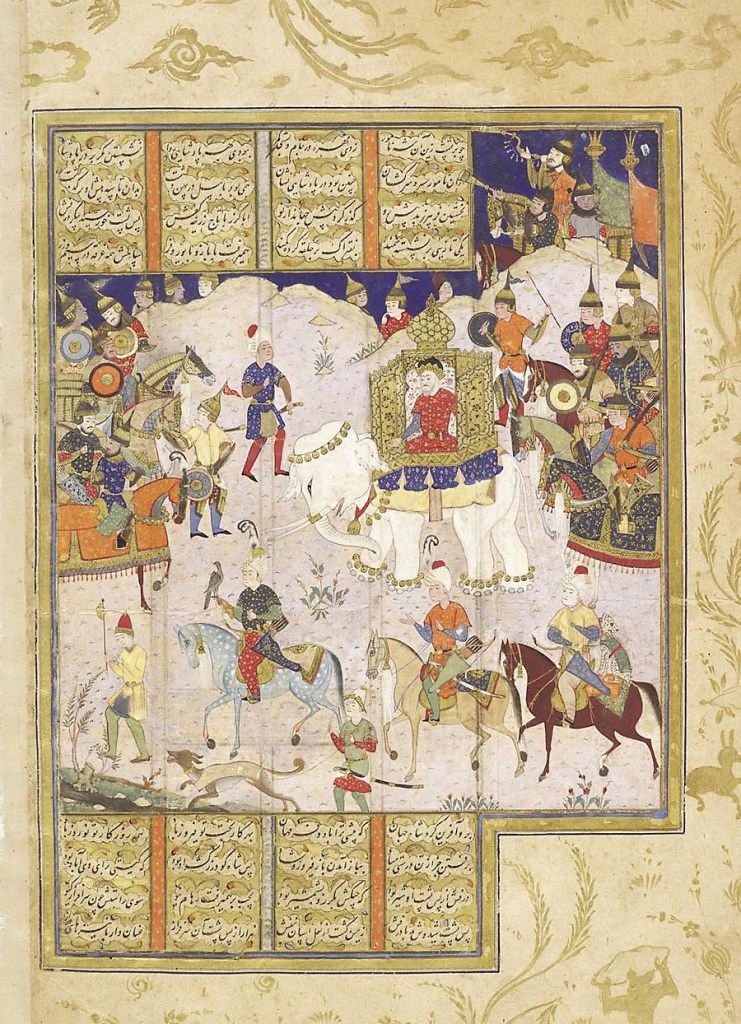
Kay Khosrow inspects his army before the eschatological battle with Afrasiab; from a manuscript of Ferdowsi’s Shahnameh painted in Shiraz in 1561-1562.
Exactly the same occurred within the context of Islam, which was preached as the utmost spirituality by Muhammad and preserved as such by Ali, Hasan, Husayn and their descendants, before several mystics and transcendental masters maintained the Islamic spiritual tradition in several mystical orders. In fact, many Islamic spiritual societies attempted to reconstruct the continuity of Mankind’s historical spirituality by duly interpreting ancient sacred texts and properly decoding mystical traditions kept in various forms of popular culture across the lands occupied by the Islamic Caliphate. This explains to great extent why many aspects and elements of earlier religions and systems of spirituality have emphatically survived within the Islamic world, notably Zervanism, Mazdakism, Mazdeism, Gayomardism, Gnosticisms, etc.
The characteristic difference that separates Christianity from Islam in terms of spirituality and the incomparably higher number of mystical orders that flourished within the Islamic world can be explained by the determinant fact that Islam as religious system is almost totally devoid of ‘cult’. This absence of the historically known and typically religious cult from Islam, as Prophet Muhammad entrusted his faith to his disciples and followers, impregnated an irrevocable mark that stood as major obstacle to all efforts of degrading this system of spirituality to a profanity.
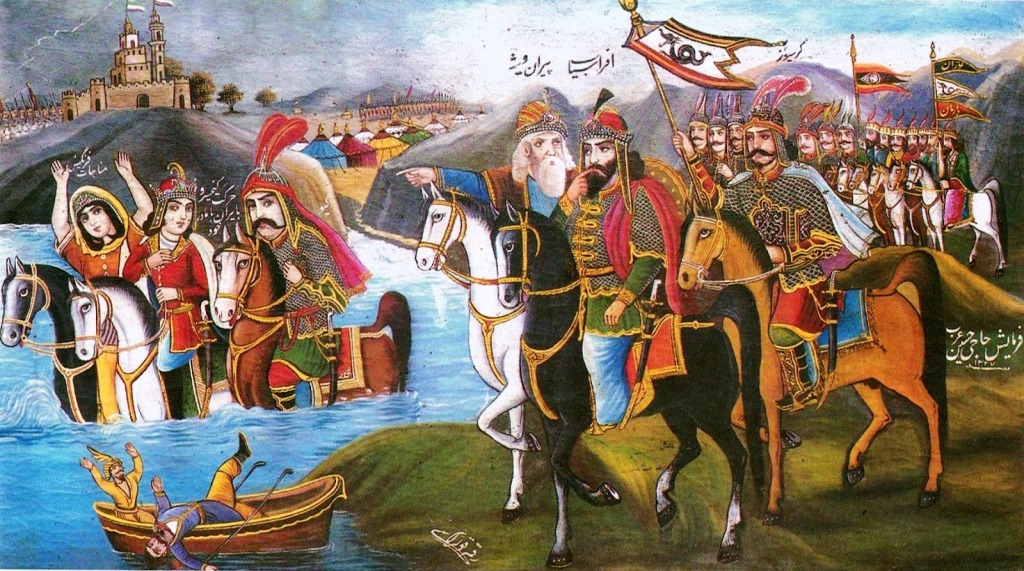
Ferdowsi’s Shahnameh, epic eschatology, Islamic mysticism, traditional painting, and popular spirituality: the departure of the mother and the grandmother of Kay Khosrow for Iran (by Hossein Qollar-Aqasi): the most adverse moment in Kay Khosrow’s transcendental life.
Of course, the earliest form of theological distortion of Islam was undertaken by immoral and evil theologians who were hired by the Umayyad and the Abbasid caliphs in order to justify their criminal acts and anti-Islamic practices. In Chapter XXI (The fabrication of the fake divide ‘Sunni Islam vs. Shia Islam’), I offer many examples in this regard. However, in the process of theological systematization of Islam (known as madhhab), there appeared systems of theological jurisprudence, which looked quite normal in the beginning, but later turned Islam into a system of rationalistic verbalism, juristic nominalism, and materialistic dogmatism. In their verbosity, the original spirituality was lost forever.
At a later stage, pathetic, ignorant and evil theologians considered every Muslim’s connection with the spiritual universe and God (which is Islam’s sole purpose) as their own personal interest and business, and they consequently reduced Prophet Muhammad’s preaching to a silly list of dos and don’ts (as if spirituality and religion are a schoolboy’s lesson). To best express their monstrous identity, they hijacked the madhhab (theological schools of jurisprudence) in order to instrumentalize them as tools of pseudo-religious oppression; first, they undertook vast campaigns against the Islamic sciences in order to plunge the believers into ignorance, and then, they fanaticized their idiotic, uneducated and illiterate followers at a time of conflict (notably the Crusades), turning them against various Islamic mystical orders or independent mystics.
These evil theologians, on whom today’s fake Islam is based, caused an incredible bloodshed throughout the Islamic world; however, it is essential to distinguish between
a) the early bloodshed that took place in the 7th and 8th c. due to orders of caliphs, who cared about how to secure their illegal grab of power from the early Islamic mystics and descendants of Prophet Muhammad (notably Ja’far al-Sadiq, sixth imam of all Muslims; 702-765), and
b) the later, longer and more atrocious bloodshed that covered the period between the 9th and the 15th c. and which was caused by evil theologians, who wanted to control the Muslims by plunging them into ignorance, barbarism, ignominy, and fallacious interpretation of the sacred texts on the basis of their own pseudo-Islamic theological system.
What these theologians, and more particularly the disreputable Ahmed ibn Hanbal and the cursed Ahmad ibn Taimiyyah, did was a literal Christianization of Islam; they viciously interpolated their juristic doctrines between the Man (in this case, the Muslim) and God (Allah). These theological doctrines consist in an impermissible intermediate that breaks the connection of man with the spiritual universe and God. And to do this, these Satanic theologians butchered numerous mystics whom they failed to understand in the first place. Great examples in this regard are Mansour Hallaj (858-922; lashed terribly and then decapitated) and Imadaddin Nasimi (1369-1417), who was accused as Hurufi, without however being so, and skinned alive.
https://en.wikipedia.org/wiki/Al-Hallaj
https://en.wikipedia.org/wiki/Imadaddin_Nasimi
Drawing therefore on earlier experience, the Safavid Order decided to take the correct measures so as to prevent the massacre of their members at the hands of ignorant pseudo-Muslims fanaticized by Satanic theologians (who may have been indiscriminately ‘qadis’, ‘sheikhs’ and ‘imams’) and shamelessly bribed or favored by Ottoman sultans. Having been launched by, and named after, Safi-ad-Din Ardabili (1252–1334) at the end of the 13th c., the Safavid Order was a band of mystics, an assembly of enlightened Muslims, and a confederation of the true faithful, who performed the royal art, carrying out acts of devotion and spiritual salvation, while engaging in diverse techniques of spirituality. They were the friends of Christians, Parsis, Yazidis, Jews, Ahl-e Haq, Tengrists, Hindus, and Buddhists.
After having operated for two centuries, at the times of the Order’s Grandmaster Shaykh Haydar (1459-1488), the Safavid Order launched another secret society, namely the Qizilbash (Kızılbaş /(قزلباش, i.e. the “red headed” (because of their red headgear); the Qizilbash functioned as the army of the Safavid Order and they duly prevented all pseudo-Muslim theologians and their cursed followers from asserting their evil power across lands that the Qizilbash controlled, thus fully defending the members of the (hereditary) Safavid Order.
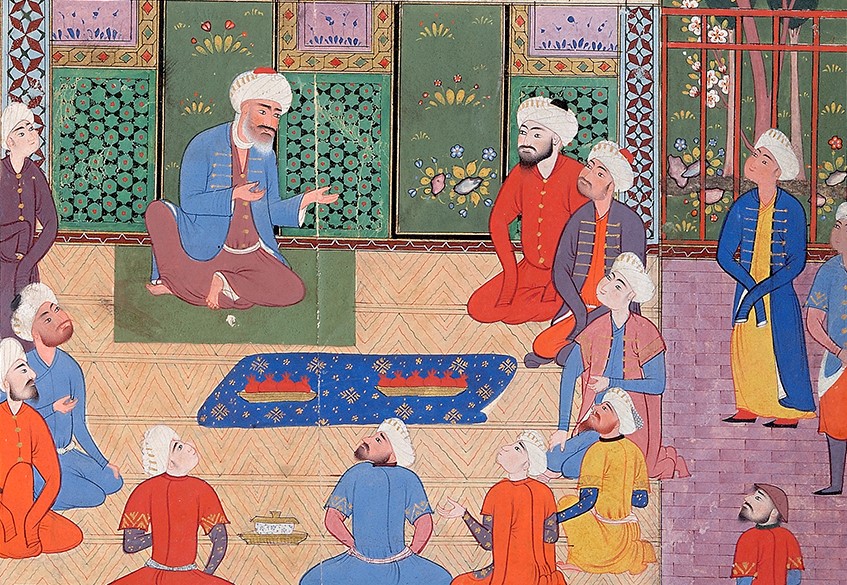
Safi ad-din Ardabili surrounded by his disciples, as illustrated in a 16th-century Safavid manuscript of the Safvat as-safa
Soon after their early successes, at the end of the 15th c., the mystical order and their army branch, knowing very well that the degenerate Islamic theologians would destroy the entire Islamic world, decided to set up their own state, which would be an empire ruled by the Safavid Order and predestined to save the Islamic world from total decay, slavery and decomposition. This type of state would not be and actually was not a religious or theological state; quite contrarily, it was a secular empire ruled by the mystical order. Automatically, every pseudo-Muslim theologian and every pseudo-Islamic state, which was nominally ruled by a sultan, emir, khan or king, but essentially it was governed by the bogus-religious authorities and the evil theologians, was found at the very antipodes of Safavid Iran.
It is crucial at this point to state that when the theologians put the monarch under control in a pseudo-Muslim state, this consists in the repetition of a phenomenon known only too well within the Christian world: Papo-Caesarism. No Christian and no Muslim state can adopt the Papo-Caesarist model. Spirituality imposes imperial rule, and this means Caesaropapism. This was solemnly introduced by Justinian I throughout the Roman Empire; it is for this reason that immediately after the death of prophet Muhammad, the followers of Ali asserted that only the prophet’s cousin and son-in law could possibly be the ruler of the Caliphate. Despite Ali’s astounding spiritual qualifications, his rule would follow the Caesaropapist pattern.
As a matter of fact, there cannot be religious evaluation of spiritual matters; this reality, which was never accepted by religious authorities and theologians alike (because it would herald their deserved dissolution and ultimate disappearance), is viciously concealed behind the Western confusion between spirituality (spiritalitas or numen / maneviyat/ معنویت/ الروحانية/靈性/ духовность) and religion (religio/din/ دین/宗教/ религия). Suffice it to check the most common definitions of spirituality and religion that are available online; there one gets a clear idea of the materialistic distortion of both terms’ meaning.
https://en.wikipedia.org/wiki/Spirituality
https://en.wikipedia.org/wiki/Religion
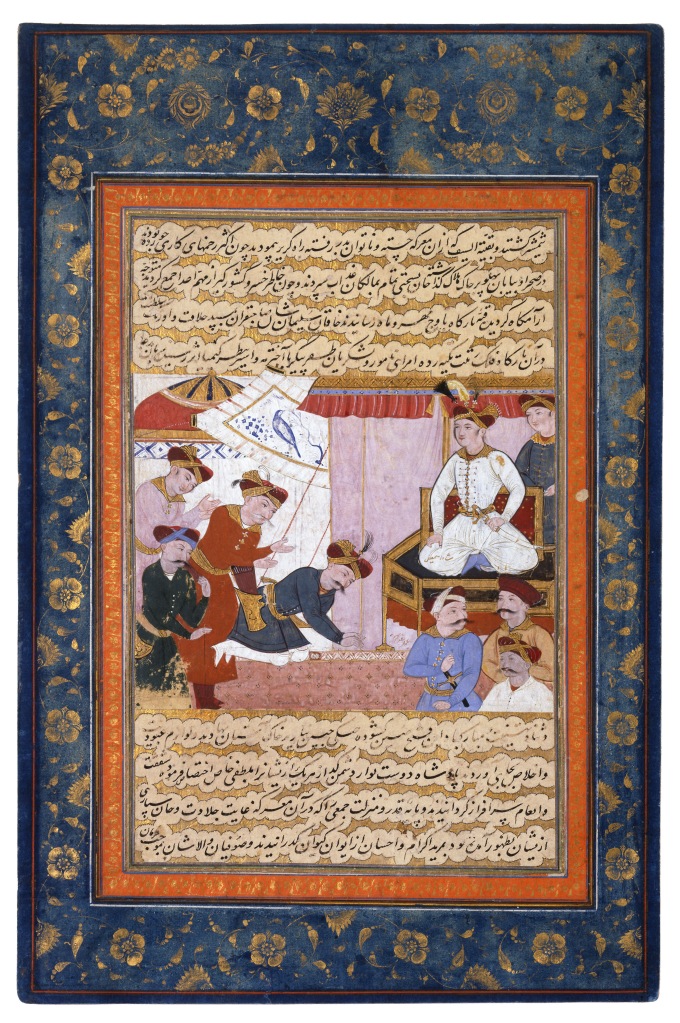
Miniature created by Mo’en Mosavver: Shah Ismail I holds an audience and welcomes the Qizilbash after they defeated the Shirvanshah Farrukh Yasar; album leaf from a copy of Bijan’s Tarikh-i Jahangusha-yi Khaqan Sahibqiran (A History of Shah Ismail I), produced in Isfahan, end of the 1680s
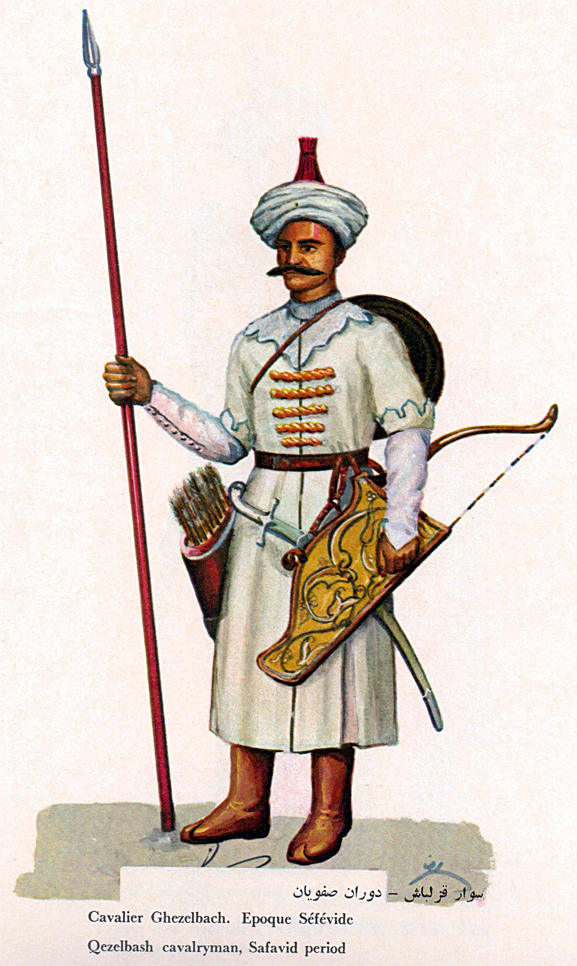
Drawing of a typical Qizilbash soldier
Then, what is fallaciously termed as “Safavid conversion of Iran to Shia Islam” describes in reality the mere rise of the Safavid Order in large parts of Western Asia and the effort to eliminate the monstrous, pseudo-Muslim theologians who want to rule on the basis of their false Sharia, and of their pernicious interpretations of the sacred texts. Not one Safavid Emperor called himself a “Shia” and not one Ottoman Sultan used this term for the Safavid rulers, with whom the Ottomans fought so many times, although they were all Turanians. About:
https://www.doaks.org/resources/middle-east-garden-traditions/introduction/safavid
https://iranicaonline.org/articles/safavids
https://asiasociety.org/education/irans-safavid-dynasty
http://www.iranchamber.com/history/safavids/safavids.php
Click to access jaas072001.pdf
https://courses.lumenlearning.com/atd-tcc-worldciv2/chapter/safavid-empire/
https://www.tandfonline.com/eprint/AXGWQG8WUIK2YIQ4YNSV/full?target=10.1080%2F00210862.2019.1647096
https://journals.openedition.org/abstractairanica/4628
https://iranicaonline.org/articles/safavids-ii
https://www.researchgate.net/publication/291722345_The_Khalifeh_al-kholafa_of_the_Safavid_Sufi_order
https://ghorbany.com/inspiration/persian-empires-chapter-5
http://www.fsmitha.com/h3/h17isl.html
http://www.artarena.force9.co.uk/safavid.html
https://www.persee.fr/doc/anatm_1297-8094_1997_num_7_1_946
https://www.soas.ac.uk/lmei-cis/events/idea-of-iran/27oct2018-the-idea-of-iran-the-safavid-era.html
https://en.wikipedia.org/wiki/Tariqa
https://en.wikipedia.org/wiki/Sufism
https://tr.wikipedia.org/wiki/Kızılbaş
https://az.wikipedia.org/wiki/Qızılbaş
https://fa.wikipedia.org/wiki/قزلباش
https://ru.wikipedia.org/wiki/Кызылбаши
https://ru.wikipedia.org/wiki/Кызылбаши_(Пенджаб)
https://ru.wikipedia.org/wiki/Сефи_ад-Дин
https://ru.wikipedia.org/wiki/Сефевиды
https://en.wikipedia.org/wiki/Safavid_order
https://en.wikipedia.org/wiki/Safavid_conversion_of_Iran_to_Shia_Islam
https://en.wikipedia.org/wiki/Safavid_Iran
https://en.wikipedia.org/wiki/Safavid_dynasty
https://en.wikipedia.org/wiki/Qizilbash
Rıza Yıldırım, The Safavid-Qizilbash Ecumene and the Formation of the Qizilbash-Alevi Community in the Ottoman Empire, c. 1500–c. 1700
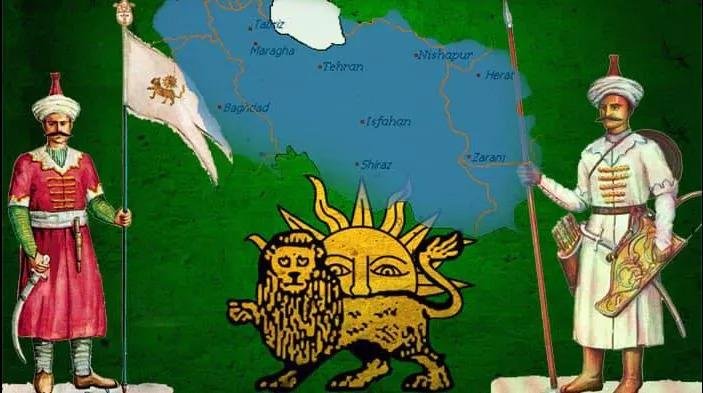
——————————————————–
FORTHCOMING
Turkey is Iran and Iran is Turkey
2500 Years of indivisible Turanian – Iranian Civilization distorted and estranged by Anglo-French Orientalists
By Prof. Muhammet Şemsettin Gözübüyükoğlu
(Muhammad Shamsaddin Megalommatis)
TABLE OF CONTENTS
PREFACE
CONTENTS
PART ONE. INTRODUCTION
CHAPTER I: A World held Captive by the Colonial Gangsters: France, England, the US, and the Delusional History Taught in their Deceitful Universities
A. Examples of fake national names
a) Mongolia (or Mughal) and Deccan – Not India!
b) Tataria – Not Russia!
c) Romania (with the accent on the penultimate syllable) – Not Greece!
d) Kemet or Masr – Not Egypt!
e) Khazaria – not Israel!
f) Abyssinia – not Ethiopia!
B. Earlier Exchange of Messages in Turkish
C. The Preamble to My Response
CHAPTER II: Geopolitics does not exist.
CHAPTER III: Politics does not exist.
CHAPTER IV: Turkey and Iran beyond politics and geopolitics: Orientalism, conceptualization, contextualization, concealment
A. Orientalism
B. Conceptualization
C. Contextualization
D. Concealment
PART TWO. EXAMPLE OF ACADEMICALLY CONCEALED, KEY HISTORICAL TEXT
CHAPTER V: Plutarch and the diffusion of Ancient Egyptian and Iranian Religions and Cultures in Ancient Greece
PART THREE. TURKEY AND IRAN BEYOND POLITICS AND GEOPOLITICS: REJECTION OF THE ORIENTALIST, TURKOLOGIST AND IRANOLOGIST FALLACIES ABOUT ACHAEMENID HISTORY
CHAPTER VI: The fallacy that Turkic nations were not present in the wider Mesopotamia – Anatolia region in pre-Islamic times
CHAPTER VII: The fallacious representation of Achaemenid Iran by Western Orientalists
CHAPTER VIII: The premeditated disconnection of Atropatene / Adhurbadagan from the History of Azerbaijan
CHAPTER IX: Iranian and Turanian nations in Achaemenid Iran
CHAPTER X: Iranian and Turanian Religions in Pre-Islamic Iran
PART FOUR. FALLACIES ABOUT THE SO-CALLED HELLENISTIC PERIOD, ALEXANDER THE GREAT, AND THE SELEUCID & THE PARTHIAN ARSACID TIMES
CHAPTER XI: Alexander the Great as Iranian King of Kings, the fallacy of Hellenism, and the nonexistent Hellenistic Period
CHAPTER XII: Parthian Turan: an Anti-Persian dynasty
CHAPTER XIII: Parthian Turan and the Philhellenism of the Arsacids
PART FIVE. FALLACIES ABOUT SASSANID HISTORY, HISTORY OF RELIGIONS, AND THE HISTORY OF MIGRATIONS
CHAPTER XIV: Arsacid & Sassanid Iran, and the wars against the Mithraic – Christian Roman Empire
CHAPTER XV: Sassanid Iran – Turan, Kartir, Roman Empire, Christianity, Mani and Manichaeism
CHAPTER XVI: Iran – Turan, Manichaeism & Islam during the Migration Period and the Early Caliphates
PART SIX. FALLACIES ABOUT THE EARLY EXPANSION OF ISLAM: THE FAKE ARABIZATION OF ISLAM
CHAPTER XVII: Iran – Turan and the Western, Orientalist distortions about the successful, early expansion of Islam during the 7th – 8th c. CE
CHAPTER XVIII: Western Orientalist falsifications of Islamic History: Identification of Islam with only Hejaz at the times of the Prophet
CHAPTER XIX: The fake, Orientalist Arabization of Islam
CHAPTER XX: The systematic dissociation of Islam from the Ancient Oriental History
PART SEVEN. THE FICTIONAL DIVISION OF ISLAM INTO ‘SUNNI’ AND ‘SHIA’
CHAPTER XXI: The fabrication of the fake divide ‘Sunni Islam vs. Shia Islam’
PART EIGHT. THE DISTORTED TERM ‘PERSIANATE’
CHAPTER XXII: The fake Persianization of the Abbasid Caliphate
PART NINE. FALLACIES ABOUT THE GOLDEN ERA OF THE ISLAMIC CIVILIZATION
CHAPTER XXIII: From Ferdowsi to the Seljuk Turks, Nizam al Mulk, Nizami Ganjavi, Jalal ad-Din Rumi and Haji Bektash
PART TEN. FALLACIES ABOUT THE TIMES OF TURANIAN (MONGOLIAN) SUPREMACY IN TERMS OF SCIENCES, ARTS, LETTERS, SPIRITUALITY AND IMPERIAL UNIVERSALISM
CHAPTER XXIV: From Genghis Khan, Nasir al-Din al Tusi and Hulagu to Timur
CHAPTER XXV: Timur (Tamerlane) as a Turanian Muslim descendant of the Great Hero Manuchehr, his exploits and triumphs, and the slow rise of the Turanian Safavid Order
CHAPTER XXVI: the Timurid Era as Peak of the Islamic Civilization, Shah Rukh, and Ulugh Beg, the Astronomer Emperor
PART ELEVEN. HOW AND WHY THE OTTOMANS, THE SAFAVIDS AND THE MUGHALS FAILED
CHAPTER XXVII: Ethnically Turanian Safavids & Culturally Iranian Ottomans: two identical empires that mirrored one another
CHAPTER XXVIII: Spirituality, Religion & Theology: the fallacy of the Safavid conversion of Iran to ‘Shia Islam’
CHAPTER XXIX: Selim I, Ismail I, and Babur
CHAPTER XXX: The Battle of Chaldiran (1514), and how it predestined the Fall of the Islamic World
CHAPTER XXXI: Ottomans, Safavids and Mughals: victims of their sectarianism, tribalism, theology, and wrong evaluation of the colonial West
CHAPTER XXXII: Ottomans, Iranians and Mughals from Nader Shah to Kemal Ataturk
PART TWELVE. CONCLUSION
CHAPTER XXXIII: Turkey and Iran beyond politics and geopolitics: whereto?
—————————————————
List of the already pre-published chapters of the book
Lines separate chapters that belong to different parts of the book.
CHAPTER X: Iranian and Turanian Religions in Pre-Islamic Iran
https://www.academia.edu/105664696/Iranian_and_Turanian_Religions_in_Pre_Islamic_Iran
—————————-
CHAPTER XI: Alexander the Great as Iranian King of Kings, the fallacy of Hellenism, and the nonexistent Hellenistic Period
CHAPTER XII: Parthian Turan: an Anti-Persian dynasty
https://www.academia.edu/52541355/Parthian_Turan_an_Anti_Persian_dynasty
CHAPTER XIII: Parthian Turan and the Philhellenism of the Arsacids
https://www.academia.edu/105539884/Parthian_Turan_and_the_Philhellenism_of_the_Arsacids
———————————
CHAPTER XIV: Arsacid & Sassanid Iran, and the wars against the Mithraic – Christian Roman Empire
CHAPTER XV: Sassanid Iran – Turan, Kartir, Roman Empire, Christianity, Mani and Manichaeism
CHAPTER XVI: Iran – Turan, Manichaeism & Islam during the Migration Period and the Early Caliphates
———————————-
CHAPTER XVII: Iran–Turan and the Western, Orientalist distortions about the successful, early expansion of Islam during the 7th-8th c. CE
CHAPTER XIX: The fake, Orientalist Arabization of Islam
https://www.academia.edu/105713891/The_fake_Orientalist_Arabization_of_Islam
CHAPTER XX: The systematic dissociation of Islam from the Ancient Oriental History
—————————————
CHAPTER XXI: The fabrication of the fake divide ‘Sunni Islam vs. Shia Islam’
https://www.academia.edu/55139916/The_Fabrication_of_the_Fake_Divide_Sunni_Islam_vs_Shia_Islam_
——————————————
CHAPTER XXII: The fake Persianization of the Abbasid Caliphate
https://www.academia.edu/61193026/The_Fake_Persianization_of_the_Abbasid_Caliphate
——————————————–
CHAPTER XXIII: From Ferdowsi to the Seljuk Turks, Nizam al Mulk, Nizami Ganjavi, Jalal ad-Din Rumi and Haji Bektash
————————————————
CHAPTER XXIV: From Genghis Khan, Nasir al-Din al Tusi and Hulagu to Timur
CHAPTER XXV: Timur (Tamerlane) as a Turanian Muslim descendant of the Great Hero Manuchehr, his exploits and triumphs, and the slow rise of the Turanian Safavid Order
CHAPTER XXVI: The Timurid Era as the Peak of the Islamic Civilization: Shah Rukh, and Ulugh Beg, the Astronomer Emperor
—————————————–
CHAPTER XXVII: Ethnically Turanian Safavids & Culturally Iranian Ottomans: two identical empires that mirrored one another
———————————————————————-
Download the chapter (text only) in PDF:
Download the chapter (with pictures and legends) in PDF:

